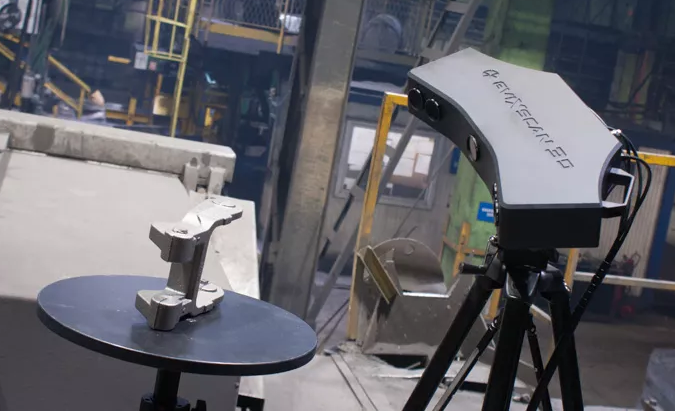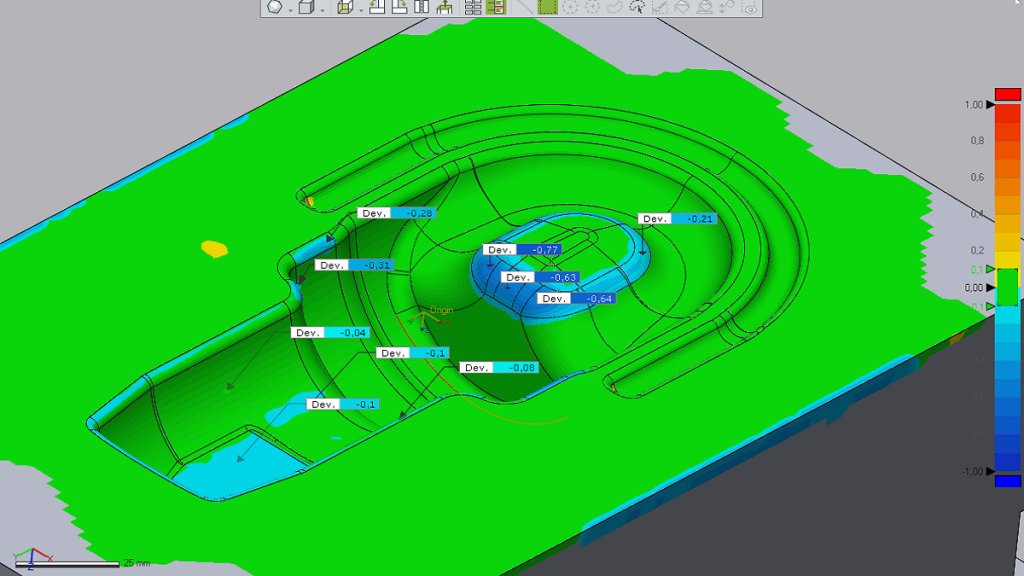Beyond the Naked Eye: 3D Scanners Are Forging a New Standard of Precision in the Foundry Industry
In the foundry industry, precision is not a luxury; it’s the bedrock of production. Whether casting critical engine components or drop-forging high-stress tools, the dimensional integrity of molds, dies, and final parts is paramount.
The Unforgiving World of Foundry Metrology
A single error, measured in micrometers, can propagate into catastrophic failures, costly production halts, and a loss of customer trust. For decades, the industry relied on traditional metrology tools – calipers, coordinate measuring machines (CMMs), and manual gauges. While effective for simple geometries, these methods buckle under the complexity and scale of modern foundry applications. They are often time-consuming, operator-dependent, and fail to capture the full-surface data of intricate castings and worn tooling.
This gap has paved the way for a technological revolution: non-contact 3D scanning. Among the vanguards of this shift is eviXscan 3D, a provider of high-precision scanners based on structured light technology. These systems are moving metrology from the isolated QC lab directly to the foundry floor, enabling a new paradigm of comprehensive, fast, and actionable quality assurance.
A Technological Leap in Quality Control
 3D scanners utilize high-resolution cameras and powerful blue LED structured light sources. This technology allows for the rapid acquisition of millions of data points, creating a dense, highly accurate “digital twin” of a physical object in minutes. Certified to rigorous VDI/VDE standards, these scanners provide the accuracy (with some models reaching precision below 0.01 mm) that the foundry industry demands.
3D scanners utilize high-resolution cameras and powerful blue LED structured light sources. This technology allows for the rapid acquisition of millions of data points, creating a dense, highly accurate “digital twin” of a physical object in minutes. Certified to rigorous VDI/VDE standards, these scanners provide the accuracy (with some models reaching precision below 0.01 mm) that the foundry industry demands.
The applications extend far beyond simple verification:
Full-Surface Quality Control: Instead of spot-checking points with a CMM, a 3D scan captures the entire part geometry. This data is then compared directly against the original CAD model, generating an intuitive color-deviation map. This visual report instantly highlights any warpage, shrinkage, or dimensional inaccuracies, allowing for immediate process correction.
Reverse Engineering: Legacy parts, molds, or dies without existing 3D models are a common challenge. A 3D scanner can digitize these assets, allowing for their repair, remanufacturing, or modification.
Wear and Tear Analysis: The ability to digitally archive molds and dies after every production run provides invaluable data. By comparing scans over time, engineers can precisely track wear patterns, predict tool failure, and optimize maintenance schedules, extending the life of critical assets.
Eliminating Production Errors in Drop Forging
 The transformative impact of this technology is powerfully illustrated by the case of a leading European manufacturer with over 30 years of experience producing drop forgings for demanding sectors like automotive, construction, and heavy machinery. This prominent forging company faced a critical bottleneck: the manual measurement of complex forging dies. These traditional methods were not only slow but, more importantly, prone to inaccuracies. Any deviation in the die – the very heart of the forging process – led directly to production errors and, subsequently, costly customer complaints.
The transformative impact of this technology is powerfully illustrated by the case of a leading European manufacturer with over 30 years of experience producing drop forgings for demanding sectors like automotive, construction, and heavy machinery. This prominent forging company faced a critical bottleneck: the manual measurement of complex forging dies. These traditional methods were not only slow but, more importantly, prone to inaccuracies. Any deviation in the die – the very heart of the forging process – led directly to production errors and, subsequently, costly customer complaints.
The company implemented an eviXscan 3D Quadro+ scanner paired with powerful inspection software (Geomagic Control X). The Quadro+ was particularly well-suited for the task, offering a versatile dual-scanning range to capture both the fine details of small dies and the larger geometry of bigger components.
The results were not just incremental; they were revolutionary.
Near-Zero Error Rate: Scanning became the first and most critical step in die verification. By creating high-fidelity digital twins of their dies before they entered production, the company could instantly validate them against CAD models. This proactive approach drastically reduced production errors and saw customer complaints drop to virtually zero.
A New Tool for Maintenance: The scanner’s utility quickly spread beyond the QC department. The maintenance team began using the Quadro+ to scan damaged or worn machine parts. This allowed them to quickly reverse-engineer components for repair or fabrication, significantly minimizing production downtime.
The Digital Archive: Every scan now contributes to a comprehensive digital database of die measurements. This invaluable archive is used to analyze long-term wear, support R&D for better die design, and provide customers with irrefutable quality documentation.
Scaling for Industry 4.0
This manufacturer’s story is a microcosm of a broader industry trend. eviXscan 3D’s technology is inherently built for the modern, automated factory. Its scanners can be integrated with collaborative robots (cobots) to create fully automated, in-line inspection cells. This allows for 24/7 quality control directly on the production line, providing real-time feedback and bringing the foundry one step closer to the ‘plug and produce’ ideals of Industry 4.0.
For the modern foundry, 3D scanning is no longer an emerging technology; it is an essential metrology tool. Scanning solutions are solving the industry’s most pressing challenges by providing unparalleled speed, accuracy, and data completeness. By moving beyond the limitations of traditional measurement, foundries can now ensure the integrity of their most complex tools and products, slash waste, optimize processes, and forge a new future built on a foundation of verifiable precision.
For more information: www.evixscan3d.com








